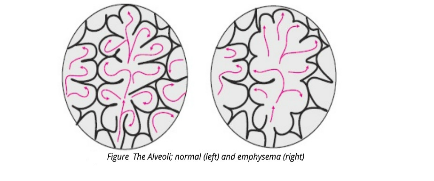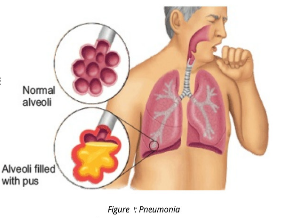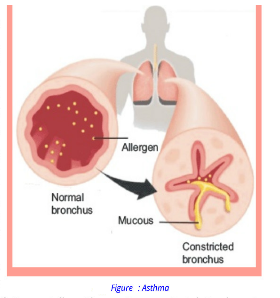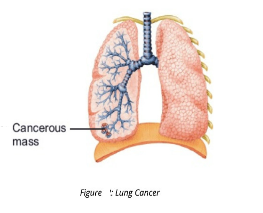Q.9 Describe different types of respiratory disorders in man. Q.9 Describe different types of respiratory disorders in man.
Answer:
There are a number of respiratory disorders which affect people. The high percentage of respiratory disorders in Pakistan is due to more concentration of air pollutants both in urban and rural atmosphere.
Some of the important respiratory disorders are:
i.Bronchitis
a) Introduction
It is the inflammation of the bronchi or bronchioles.
b) Causes
i) It results in excessive secretion of mucous into the tubes, leading to the swelling of tubular walls and narrowing of tubes.
ii) It is caused by viruses, bacteria or exposure to chemical irritants (e.g. tobacco smoke).
c) Types
There are two major types of bronchitis i.e. acute and chronic.
i) Acute Bronchitis
It usually lasts about two weeks and patient recovers with no permanent damage to bronchi or bronchioles.
ii) Chronic bronchitis
In chronic bronchitis, the bronchi develop chronic inflammation. It usually lasts for three months to two years.
d) Symptoms
Symptoms of bronchitis include: Cough Mild wheezing Fever Chills Shortness of breath (especially when doing hard job)
e) Age limit
The majority of people diagnosed with chronic bronchitis are 45 years of age or older.
ii. Emphysema Introduction
It is the destruction of the walls of the alveoli.
Explanation
It results in larger sacs but with less surface area for gaseous exchange. As lung tissue breaks down, the lungs do not come back to their original shape after exhalation so air cannot be pushed out and is trapped in the lungs.
Symptoms
It includes: 1. Shortness of breath ii. Fatigue iii. Recurrent respiratory infections. iv. Weight loss By the time the symptoms of emphysema appear, the patient has usually lost 50% to 70% of his/her lung tissue.
Effects
The level of oxygen in blood may get so low that it causes serious complications.
iii. Pneumonia Introduction
It is an infection of lungs.
Double pneumonia
If this infection affects both lungs, it is called double pneumonia.
Causes
The most common cause of pneumonia is a bacterium, Streptococcus pneumonia. Some viral influenza virus) and fungal infections may also lead to pneumonia.
Explanation
When the causative organisms enter the alveoli, they break the lung tissues and the area is filled with fluid and pus.
Symptoms
It includes a cold that is followed by a high fever, shivering, and a cough with sputum production. Patient may become short of breath.
Effects
The patient‘s skin colour may change and become dusky or purplish. It is due to poor oxygenation of blood.
Treatment
i. Vaccines are available to prevent pneumonia caused by S. pneumonia.
ii. Antibiotics are used in the treatment of this disease.
iv. Asthma
Introduction
It is a form of allergy, in which there is inflammation of the bronchi, more mucous production and narrowing of the airways.
Explanation
In asthma patients, the bronchi and bronchioles become sensitive to different allergens (allergy causing factors) e.g. dust, smoke, perfumes, pollens etc. When exposed to any of such allergens, the sensitive airways show immediate and excessive response of constriction. In this condition, the patient feels difficulty in breathing.
Symptoms
It varies from person to person. It includes:
i. Shortness of breath (especially with exertion or at night)
ii. Wheezing (whistling sound when breathing out)
iii. Cough
iv. Chest tightness
Treatment
The medicine in the form of inhalers with ability to dilate the bronchi and bronchioles are used in the treatment of asthma.
(v) Lung Cancer / Explain lung cancer and Passive smoking
Introduction
It is a disease of uncontrolled cell divisions in the tissues of the lung.
Explanation
In lung cancer, cells continue to divide without any control and form tumours. The cellular growth may also invade adjacent tissues beyond the lungs.
Symptoms
The most common symptoms are:
i. Shortness of breath
ii. Coughing (including coughing up blood)
Causes
(1) Main cause:
Smoking is the main cause of lung cancer.
(2) Other Causes are:
(i) Carcinogens (such as those in cigarette smoke)
(ii) lonizing radiation
(iii) Viral infection
Known number of carcinogens
Cigarette smoke contains over 50 known carcinogens.
Lung cancer in non–smokers
The risk of lung cancer is significantly lower in non–smokers. Passive smoking (the inhalation of smoke from another‘s smoking) is also a cause of lung cancer. The smoke from the burning end of a cigarette is more dangerous than the smoke from the filter end.
Prevention
(i) Eliminating tobacco smoking is a primary goal in the prevention of lung cancer.
(ii) The World Health Organization has called for governments to stop tobacco advertising to prevent young people from taking up smoking.
(iii) If a person stops smoking the chance to develop cancer decreases as damage to the lungs is repaired and contaminant particles are gradually removed.
Effects
Lung cancer is the most common cause of cancer–related deaths and is responsible for more than .
1.3 million deaths worldwide annually.



